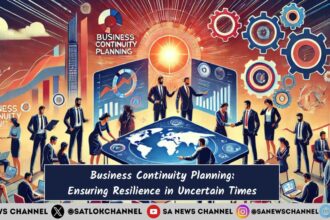Did you know that 68% of the world population is expected to live in urban areas by 2050? But what does that mean? More traffic jams, rising pollution, energy crisis, and overwhelmed public services. Conventional metropolitan cities especially in India — including the National Capital Delhi, Mumbai, Hyderabad, Chennai and many others, are on the verge of collapsing. However, a groundbreaking development is set to redefine urban living: Smart City Technology.
With the development of AI and more developments under-way, the future is indeed becoming clearer now. From self-regulating traffic systems, minimising congestion to AI-driven public safety features, preventing crime before occurrence, the cities of tomorrow are taking shape. Making the most of technological advancements in Internet of Things (IoT), Artificial Intelligence (AI), Big Data, 5G, and Blockchain, Smart Cities are developing with sustainable, efficient and highly connected ecosystems.
But how are these cities evolving and operating? Can technology truly empower urban living? The article is a guide about Smart City Technology, exploring its impact, challenges and how it solves real-life big problems with examples from Barcelona, Dubai, Singapore and many others, setting the stage for the future to arrive.
Evolution of Smart Cities
Smart cities evolved with time and the development of technology over the years. Let’s explore a short decade-wise timeline about when technology came into existence:
- 1990s – With the innovation of the internet, the term ‘digital city’ came into existence which laid the foundation stone for smart cities.
- Early 2000s – Governments and cities across the globe started experimenting with technological advancements like IoT sensors to enhance public services.
- Late 2000s – Government and cities started to invest heavily for smart cities development. The term smart city became popular during this period. Barcelona and Amsterdam were earlier pioneers.
- 2010s – AI and ML became more prevalent, innovation related to smart mobility solutions such as autonomous vehicles, and intelligent transportation systems became popular.
- 2020s – After the COVID-19 pandemic the need for digital infrastructure surged rapidly. The interest of people started to move towards sustainable development to lower carbon emissions while maintaining standardised urban living.
The Problem in Traditional Cities & How Smart Cities Solve Them
- With growing urbanisation the problems like traffic jams, energy inefficiency, inefficient governance, public safety concerns and pollution are also on the rise.
- Smart Cities make use of cutting edge technologies like Internet of Things (IoT), Artificial Intelligence (AI), Big Data, Smart Mobility Systems and many others to make urban living more desirable.
- Let us examine some of the key urban challenges and the capabilities of Smart Cities to tackle them with real-life examples.
Traffic Jam Issues — Solution: Smart Mobility Systems
- Challenge: Today, traffic jams and congestion are a problem in every other city, especially in India. It not only causes congestion on roads but also results in pollution, wastage of time and fuel.
- Solution: Smart Mobility Systems integrates technological advancements in AI and IoT to filter best routes, offer real time traffic updates with accuracy and improve efficiency.
- Sensors throughout the city measure the traffic flow and convey the information to a central system. The AI system interprets the data and creates a plan to move vehicles causing less traffic congestion. AI can effectively control smart traffic stop lights to control traffic flow across the city. Various cities in the US, especially New York, San Jose in California, Boulder in Colorado and many others are following this system.
- Electric Vehicles (EVs) reduce pollution and help in overall reduction of carbon emissions.
- Ride sharing & Mobility-as-a-Service (MaaS) helps reduce traffic on roads by reducing the vehicular density on roads.
- Real Life Examples: Smart traffic systems in Pittsburgh, Pennsylvania have resulted in an overall reduction of 21% in carbon emissions and a 41% decrease in wait times. (Source: Digi)
- Sydney Councils have started to detect potholes in roads caused by rain using AI. They are using deactivated smartphones on garbage trucks to scan 90% of city roads, enabling them to counter more than 10,000 defects in three months. (Source: The Telegraph)
Energy Wastage & Pollution — Solution: Smart Energy & Sustainability
- Challenge: Urban areas consume 78% of the world’s energy and cause 60% of the greenhouse gas emissions. With growing technology, pollution and energy wastage are also rising. It causes environmental and public health degradation. (Source: IEA)
- Solution: Smart Meters and Grids makes use of AI-driven energy distribution to prevent energy wastage. It is a better alternative for an efficient resource allocation.
- IoT based sensors can track energy usage in buildings which can help in managing consumption. Some road sensors can help light to turn off while detecting no pedestrian activities around them.
- Integration of renewable energy resources in urban areas can promote sustainability.
- Real Life Example: In Bahnstadt, Heidelberg, Germany, the development of energy efficient infrastructure by using cutting edge technologies have reduced the energy usage 80% as compared to traditional buildings in the area. (Source: The Time)
Inefficient Governance & Slow Public Service — Solution: E-Governance & Digital Transformation
- Challenge: Most of the government service throughout the globe is through government officials with less use of technology. It makes the system slow and less efficient.
- Blockchain can help the government to practice transparency in their transactions. It helps in making governance easier and public service convenient.
- AI-powered chatbots, mobile apps and digital identity systems have made citizen engagement quicker. It gives them instant access to government services while streamlining public administration.
- Real Life Example: Dubai is on a seven year plan to digitalise primarily all government services (90 services approximately). It includes transport, communications, infrastructure, electricity, economic services and urban planning. These services can be assessed by the people through the DubaiNow App. It has been estimated that it will save approximately $245 million USD upon completion for eliminating paper. (Source: ASME)
Less Public Safety & Security — Solution: AI-Driven Security Solutions
- Challenge: With growing urbanisation, the volume of crimes in the cities are also ever-increasing. These crimes require top-class surveillance and crime detection strategies.
- With the use of AI, ML and Big Data, government police officials can make use of predictive analysis in crime prevention before the actual occurrence of crime. The intelligent interpretation of criminal data can be used effectively.
- At public places, AI-powered surveillance and facial recognition systems can enhance public safety.
- Smart streetlights embedded with hidden cameras and sensors help in improving safety and maintain surveillance across the cities.
- Real Life Example: AI-powered cameras in California are capable enough to detect fires before it actually happens. This system is integrated into the ALERTCalifornia network. (Source: The Wall Street Journal)
Best Smart City Technologies in 2025
Strong technological advancements are the building blocks for various smart cities globally. These offer seamless management, integration and automation of various processes with just a few clicks. Further, it helps in making decision-making a lot easier. This section mentions some of the key smart city technologies making urban life efficient, reliable while maintaining sustainability.
■ Also Read: India’s Economic Growth in 2025: Key Factors
IoT — Evolving Nervous System of Smart Cities
- IoT operates by connecting various systems across the city digitally for providing real-time monitoring and surveillance. It can help in automating various city operations, for example traffic management.
- The system makes use of sensors, smart devices and data networks installed at various public places.
- Real Life Example: Barcelona makes use of approximately 20,000 IoT based sensors throughout the city to manage street lighting, waste, energy usage, traffic and parking. It helps them reduce a significant amount of cost. (Source: Bismart)
AI & ML — Making smart cities more efficient
- AI & ML has the capability to manage large datasets and extract information out of them for efficient use. These data sets can be used to optimise various public services.
- Real life example: Singapore has made use of AI-driven traffic management predictive analysis to reduce traffic congestion in the city. (Source: Smart Nation Singapore)
Big Data Analytics
- Big data analytics enables the government to analyse data, trends, predict shortcomings and act accordingly.
- Real life example: New York’s 311 system uses Big Data Analytics to analyse data of complaints and service requests from people across the city. The analytics analyses the data to identify shortcomings, thereby reducing response time.
5G Connectivity
- 5G connectivity is responsible for providing high speed internet with greater efficiency. It helps in overall efficiency as every service and technological advancement is connected to each other through the internet.
- Real life example: South Korea, a leader in 5G adoption, makes use of high speed networks in diverse fields like, education, healthcare, and transportation primarily.
Blockchain for Smart Cities
- Blockchain technology enables e-governance by making financial transactions transparent. It is a secure way of performing financial transactions in this digital era.
- Real life example: Dubai has planned to implement blockchain and shift all the government services to the digital platform completely.
Smart City Case Studies: Top 5 Smart Cities in the World
With growing infrastructure for latest technological advancements, every other city across the globe is continuously evolving itself. By making use of various cutting edge technologies like AI, IoT, 5G and Big Data, urban living is growing every other day. The following list provides the details of top 5 growing smart cities across the globe which are making the most of these technological innovations.
Singapore
- Population: 5.9 million approximately.
- Singapore has been a smart city since 2014.
- Singapore is one of the prime examples of a smart city which is making the most of the latest technological advancements to facilitate urban living.
- Singapore is using a smart traffic monitoring system to manage traffic congestion on roads.
- The country has also facilitated contactless payment systems for its large population which travel by public transport.
- For its ageing population, the country has promoted a digital health system to carry out video consultations with the help of Internet of Things devices to monitor patients remotely. It has minimised hospital visits across the nation.
- Singapore has also planned for a new eco-smart city completely free from vehicles. Singapore has been assisted by ST Engineering in integrating technology into its transportation infrastructure.
- Technologies Used: IoT, AI, ML, Big Data, Digital Governance and Smart Mobility
Barcelona
- Population: 1.6 million approximately.
- Barcelona has been a smart city since 2011.
- Barcelona is not just known for its famous football club and footballer Lionel Messi. The country is also known for making most of the latest technological advancements for improving urban living.
- Barcelona has made use of IoT sensors throughout the city for managing traffic, assisting parking, saving money on energy, and through many other ways.
- The country has partnered with Cisco, a tech giant, to develop infrastructure across the cityscape. It is also planning to expand further in the future.
- Technologies Used: IoT, Smart Grids, Smart Waste Management System
Dubai
- Population: 3.3 million
- Dubai has been a smart city since 2014
- Dubai, a tourism hub, is not just known for its marvellous architecture and iconic construction examples.
- The government of Dubai is on a goal to make it the ‘happiest city in the world’ by making use of technological innovations.
- Following the purpose, it has partnered itself with Core42, a tech giant which focuses on AI integration and applications to various sectors. These sectors include primarily healthcare and transportation.
- Dubai has driverless taxis and autonomous police robots for enhancing security and transportation.
- The nation and the government have also planned to make the city 100% digital by transferring itself on blockchain technology by 2030.
- Technologies Used: Blockchain, AI, Smart Transportation
Copenhagen: The Greenest Smart City
- Population: 6,38,970 approximately.
- Copenhagen has been classified as a Smart City since 2014
- The country is on a mission to become Carbon-neutral by 2025 with AI-driven wind and solar farms. It is also assisted by a major tech giant, Siemens in its operations.
- It has also built a system to use waste heat from power plants to warm homes.
- Following the system of smart mobility, the nation aims to make trains fully driverless by automating their infrastructure with control technology.
- Technologies Used: Renewable Energy, Smart Grids, AI in Climate Action
New York City
- Population: 8.26 million
- New York has achieved the feat of being a smart city since 2013.
- New York smart projects are based on data driven governance and AI-integration into its leading projects by partnering with IBM.
- The city has installed multiple IoT based sensors and makes use of Big Data to handle and manage citizen demands.
- Its 311 data driven governance makes use of Big Data and AI driven outputs to analyse 22 million citizen complaints annually.
- It also uses predictive analysis in Smart Grid Expansion by analysing requirements to reduce blackouts throughout the city.
- Technologies Used: Big Data, Smart Grid, AI, Predictive Analysis
(Source: Sustainability Magazine)
Smart City Challenges
The challenges incurred in a smart city development are very similar to the challenges faced in other fields where there technologies are implemented. Let’s explore them below:
Data Privacy
- With the use of cutting edge technologies like AI, IoT, Big Data and 5G, the fear of data privacy also arises. While analysing enormous amounts of data, there is a possibility of data leakage as well, putting a risk on various identities. It raises privacy and cybersecurity risks.
- Real life example: Singapore’s smart lamppost faced tremendous revolt from the public as it aims to collect facial identities by installing cameras with it.
- However, strong encryption techniques and by maintaining transparency of data, it can be avoided.
High Implementation Costs
- For building such mammoth infrastructure for smart cities it requires significant investment in IoT, 5G, AI systems and smart grids. It is not easy for every city to invest such a large amount of money on these systems, especially in countries like India, where cost plays a bigger role over quality at most of the places.
- Real life example: The mission to develop 100 smart cities across India faced a huge barrier in terms of funding. The ground realities are even more shocking with less or no quality standards.
Integration Challenges
- In some cities, the outdated infrastructure poses a huge barrier as it doesn’t sync with the new digital systems seamlessly.
- Real life example: In New York City, the advanced smart grid system was hindered by existing old electricity infrastructure.
Access to digital infrastructure
- The varying population density creates a digital divide, posing a barrier to have equal access to technologies.
- Real life example: As per a study, approximately 7.2 million Americans still lack access to the high speed internet in 2023. However, the gap is narrowing but it is still significant.
Unethical Use of AI
- AI driven automation systems are causing job displacement, biased algorithms and many others.
- The misuse of AI for facial recognition, predictive policing and automated decision making is a huge barrier to its widespread applications. It poses threats about its accuracy, privacy, fairness and human rights.
- Real life example: China uses an automated facial recognition system and assigns a ‘social credit score’ to its citizens. This score is based upon their habit of paying bills and following traffic rules.
- It not only stops here, this score can have serious outcomes, making citizens lose access to travel, loans and even jobs.
- This raises huge doubts over its widespread applications and outcomes. Presenting outcomes based on historical inequalities will not allow individuals to maintain themselves financially in the coming future.
The Future of Smart Cities
As we are witnessing today, technology seems to be reaching a new milestone every other day, the future of smart cities is indeed promising. The breakthroughs involved with AI, 5G, IoT and green technologies are continuously evolving and giving an altogether different outlook to the smart cities. Let’s examine some innovations which are certainly promising to redefine urban living in the future.
Smart Mobility & Autonomous Vehicles (AVs)
- The future of transportation is indeed smart mobility and autonomous vehicles. The use of self-driving cars, drones and buses is certainly transforming how transportation systems will move in smart cities.
- Real life example: Tesla’s Full Self-Driving (FSD) technology is certainly the future of transportation in smart cities. It not only reduces carbon emissions but also reduces accidents.
- Robotaxis are operating in countries like the US and China and are expanding slowly globally.
Smart Infrastructure — 3D Printing
- The future of sustainable and smart infrastructure is 3D printing. 3D printing is not conventional printing rather it is the construction of buildings by making use of cutting edge technologies.
- Construction of buildings, roads, bridges can be executed with lower costs as compared to the Reinforced Cement Concrete (RCC) structure while maintaining low carbon emissions.
- Real life example: Amsterdam has already started to build 3D printed real houses offering sustainable and affordable housing options for residents making it environmentally friendly.
Predictive City Management
- AI for Smart City Governance: Predictive city management is the process of managing city operations with the use of cutting edge technologies.
- The future of smart cities is based on predictive city management. By making use of the latest technological advancements, city management can effectively manage waste management, traffic congestion, energy management and crime.
- This is attained by predictive analysis and interpreting real time data across various places throughout the city. Further, it will help in the decision-making process to reduce problems of traditional cities.
- Real life example: London’s AI powered transportation system helps them to use real time analytics to predict expected traffic flows and make effective decisions to reduce traffic congestion in the city.
- Various other cities like Pittsburgh, Dubai and many others have implemented these technologies to make their transportation easier.
Green Technologies & Sustainability
- Every innovation and technological advancement is made to push the globe towards sustainable development. The development of smart cities is solely to empower products working on the principle of sustainable development.
- As these cities are developed with renewable resources, sustainable construction practices, eco-friendly transportation systems and sustainable urban planning, it is certainly the future of urban living with lower carbon emissions.
- Real life example: Copenhagen is on a mission to become a carbon-neutral city by 2025. It works on AI-powered renewable energy generation systems.
Blockchain Based Governance
- Blockchain Technology enables us to carry out seamless and transparent financial transactions. It helps to carry out e-governance with ease by securing digital identities. Further, it can also be used for voting systems.
- Real life example: Dubai and Estonia are using this technology for seamless financial transactions and cost effective voting systems effectively.
There is no denying the fact that technology is certainly the future. Smart cities are effectively transforming the lifestyles of people living in urban areas by offering efficiency, automation and sustainability. Cities are becoming ever-connected by leveraging latest innovations in AI-driven urban planning, IoT based governance and green energy solutions. But have we ever considered the ultimate purpose of this development? Have we ever paused to ask ourselves whether technology alone is enough to solve all our problems? If technology is meant to serve humanity, then why are we so much controlled by it?
The Limitations of Technology
Smart cities are capable enough to give us marvellous infrastructure but technological advancements like AI, IoT and many others cannot address issues like mental peace, moral values and spiritual well being. Consider and try thinking about following points:
- We have seen in the article that AI can predict crimes, but can it eliminate hatred and greed from our hearts?
- Smart healthcare solutions can give you better treatment, but can it extend your life after death till you desire?
- Sustainable products can reduce carbon emissions and reduce pollution but can it liberate souls from worldly distractions?
Technology is capable of giving us a luxurious life but it cannot address our internal struggles which are the cause of social unrest in the society.
Are we controlled by Technology?
Despite being its creator, still technology is shaping our decisions, habits and actions.
- Social media algorithms decide what we will see next on social media.
- AI assistants can predict our choices before we actually make them.
- The loss of jobs because of automation is pushing youth towards anxiety and stress.
And there are many other points where technology is driving us through our daily tasks. But, instead of being driven by technology, we must use it not just for gathering material wealth, but also for developing spiritual understanding.
Technology or Spirituality?
As we have seen, technology has limitations and we solely cannot rely on technology for solving all our problems. Beyond the landscape of technological advancements, our soul longs for peace, purpose and inner fulfilment, which science cannot offer.
- In Healthcare: There are countless instances where technology fails to save lives, even the doctors leave everything to God. It means science doesn’t have absolute control.
- The mystery behind Life & Death: Science claims to have known the working of our human body, yet it fails to explain that what happens when we die? What forces are keeping us alive? There is certainly a power beyond our power, controlling everything everywhere.
Jagatguru Tatvdarshi Sant Rampal Ji Maharaj has explained that this power is none other than Supreme God Kabir. He is the architect of our body and soul and resides in His eternal abode Satlok. He has further explained that technology is a useful tool of this era but it cannot overpower the supremacy of God Kabir. He explains that our prime goal is the liberation from the cycle of birth & death to attain a permanent place in Satlok.
Only by seeking refuge in Sant Rampal Ji Maharaj and following the way of worship given by Him, one can attain everlasting peace here and beyond. Technology will continue to evolve but in the absence of true spiritual wisdom, humanity cannot spread. Only the true spiritual knowledge given by Sant Rampal Ji Maharaj offers unparalleled material and eternal benefits that neither science nor technology can solely achieve.
In order to know more about His groundbreaking true spiritual knowledge watch His spiritual discourses at ‘Sant Rampal Ji Maharaj’ youtube channel or visit His website www.jagatgururampalji.org
Smart City Technology FAQs
Question: What are the key technologies in a smart city?
Answer: IoT, AI integration, Big Data & Blockchain technology
Question: How does AI improve urban infrastructure?
Answer: AI can analyse large datasets to extract patterns and help in decision-making.
Question: What are the benefits and challenges of smart city technology?
Answer: Sustainable management, time efficiency and work efficiency are some benefits while data privacy, digital divide, and unethical use of AI are some of the challenges.









